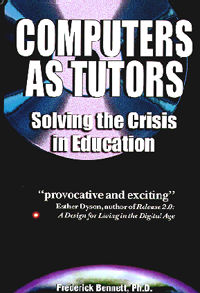|
________________
CM . . . .
Volume VI Number 8 . . . . December 10, 1999
excerpt: Today's technology, if used differently, could bring advances that would improve education dramatically. Ordinary students would make massive gains and restraints on bright students would dissolve. Wherever illiteracy is a problem, it would be eliminated, and handicapped students would have immense new vistas opened to them. If computers are to be effective in schools, however, overthrowing present practices must occur, and that frightens many people.Through 30 easy-to-read, short chapters, divided into seven sections, Computers as Tutors examines the current state of K-12 education in the United States and offers a solution to the myriad problems described. The solution? Use computers instead of teachers to deliver instruction. The first section, "A Warning and Suggested Solutions," gives a depressing, though probably accurate, assessment of the current state of K-12 education in the United States. Bennett makes reference to a number of studies that draw direct links between educational levels, illiteracy and crime rates. The perilous state of inner city schools, the gradual decline in high school graduates' SAT scores and the need for remedial classes for first year university students are offered as evidence of a dysfunctional American school system. Current prescriptions for fixing education - increased funding for schools, an ability for parents to choose schools for their children, copying successful models from other countries, and the use of the Internet - are rejected as solutions in the American context. In the second section, "Searching for a True Solution," Bennett begins to makes his case for computer delivered instruction and spends the remainder of the book rationalizing his argument. In this, he does an admirable job, foreseeing and responding to many of the objections his revolutionary proposal for computerized education would generate. He tackles problems, such as the inability of computers to develop higher order thinking, the physical problems that the extended use of computers bring, the costs associated with his proposal, and the social, personal and human contact that will be lost when computers, and not humans, deliver instruction. At its core, his notion of computer delivered instruction is based on an objectivist, didactic, transmissive, and behavioural model of teaching. Bennett addresses many of the pedagogical objections that are sure to arise by describing a new role for teachers in computerized education. Rather than replacing teachers, computers would free them to become Teacher Leaders with responsibility for creating positive learning environments, organizing collaborative and group activities, and acting as mentors for students. As he states, "Computers will instruct, teachers will educate." The logistical and financial implications of his proposal are given short shrift, as is an implementation strategy. In describing his ideal vision of education in the future, Bennett does not make clear how we get there from here. His proposal to use computers for instruction is an all-or-nothing proposition and a mammoth undertaking. Hardware, software, instructional content, evaluation procedures, teacher training and administrative reorientation would need to be in place for his new system of education to be viable. The implementation of a computer as tutor system conjures up an image of a specific point in time when a switch can be flicked and education would be delivered in an entirely new way. One line from the book kept lingering in my mind. Bennett states that "two hours of computer lab instruction can accomplish what a student would accomplish in one month of regular classes." If that were true, his system would create very short school years. Yet, he does not advocate shortening school years. In fact, he sees education as an anytime, any day, all year long opportunity. Students who quickly progress through computer delivered instruction modules would engage in supplemental activities organized by Teacher Leaders. These activities would include collaborative work with other students, advanced seminars, and field trips. Bennett's argument, that using computers for instruction would equalize educational opportunity and eliminate discrimination, is at odds with this notion of extended learning opportunities for "quick" learners. The use of computers to deliver instruction has been successfully used to deliver professional and post-secondary school education. Mature students with intrinsic motivation adapt easily to the self-guided and independent nature of computer mediated learning. Computers as Tutors makes an argument that computer based education can be utilized to deliver instruction from kindergarten to Grade 12. The book can be used to provoke discussion on the merits of incorporating technology into educational practice, but, as a guidebook for the future of education, it raises more questions than it answers. Recommended with reservations. Peter Tittenberger is the Instructional Technology Coordinator for Information Services and Technology at the University of Manitoba.
To comment on this title or this review, send mail to cm@umanitoba.ca.
Copyright © the Manitoba Library Association.
Reproduction for personal use is permitted only if this copyright notice
is maintained. Any other reproduction is prohibited without
permission.
Published by
TABLE OF CONTENTS FOR THIS ISSUE - December 10, 1999.
AUTHORS |
TITLES |
MEDIA REVIEWS |
PROFILES |
BACK ISSUES |
SEARCH |
CMARCHIVE |
HOME
|
